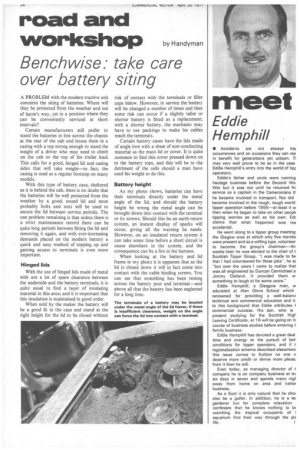road and
Page 36

If you've noticed an error in this article please click here to report it so we can fix it.
workshop by Handyman
Benchwise: take care over battery siting
A PROBLEM with the modern tractive unit concerns the siting of batteries. Where will they be protected from the weather and out of harm's way, yet in a position where they can be conveniently serviced at short intervals?
Certain manufacturers still prefer to stand the batteries in line across the chassis at the rear of the cab and house them in a casing with a top strong enough to stand the weight of a driver who may need to climb on the cab or the top of his trailer load. This calls for a good, hinged lid and casing sides that will take weight—in fact, the casing is used as a regular footstep on many models.
With this type of battery case, sheltered as it is behind the cab, there is no doubt that the batteries will be well protected from the weather by a good, sound lid and most probably bolts and nuts will be used to secure the lid between service periods. The one problem remaining is that unless there is a strict maintenance record there can be quite long periods between fitting the lid and removing it again, and with ever-increasing demands placed on the modern battery a quick and easy method of topping up and gaining access to terminals is even more important.
Hinged lids With the use of hinged lids made of metal with not a lot of spare clearance between the underside and the battery terminals, it is quite usual to, find a layer of insulating material in this area; and it is important that this insulation is maintained in good order.
When sold by the maker the battery will be a good fit in the case and stand at the right height for the lid to be closed without risk of contact with the terminals or filler caps below. However, in service the battery will be changed a number of times and then some risk can occur if a slightly taller or shorter battery is fitted as a replacement; with a shorter battery, the mechanic may have to use packings to make his cables reach the terminals.
Certain battery cases have the lids made of angle iron with a sheet of non-conducting material as the main lid or cover. It is quite common to find this cover pressed down on to the battery tops, and this-will be to the detriment of the cells should a man have used his weight to do this.
Battery height As my photo shows, batteries can have their terminals directly under the metal angle of the lid, and should the battery height be wrong the metal angle can be brought down into contact with the terminal or its screws. Should this be an earth-return system, an instant display of sparks will occur, giving all the warning he needs. However, on an insulated return system it can take some time before a short circuit is cause elsewhere in the system, and the consequence can be a fire in the harness.
When looking at the battery and lid frame in my photo it is apparent that as the lid is closed down it will in fact come into contact with the cable binding screws. You can see that something has been resting across the battery post and terminal—and above all that the battery has been neglected for a long time.




























































































